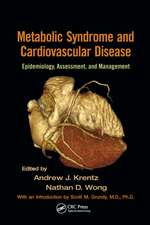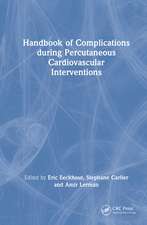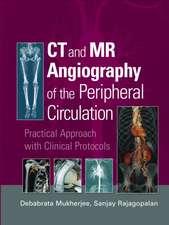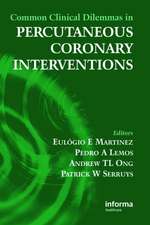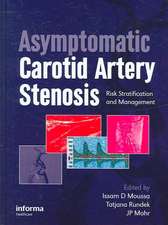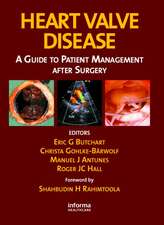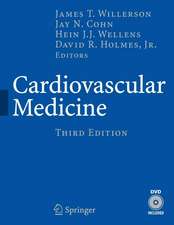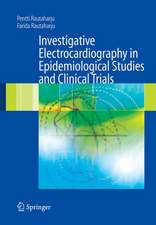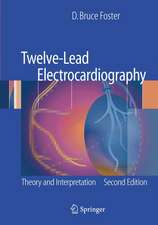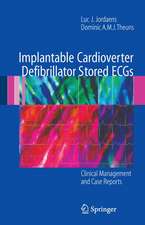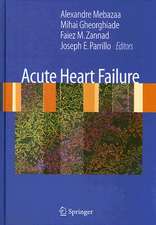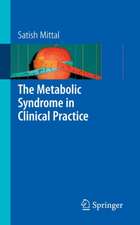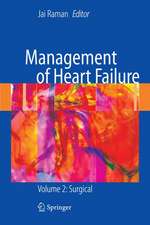Cardiovascular MRI in Practice: A Teaching File Approach
Autor John Grizzard, Robert Judd, Raymond Kimen Limba Engleză Hardback – 28 aug 2008
Preț: 1253.47 lei
Preț vechi: 1319.43 lei
-5% Recomandat
221.84€ • 259.26$ • 192.60£
Carte tipărită la comandă
Livrare economică 19 februarie-05 martie
Specificații
ISBN-10: 1848000898
Pagini: 299
Ilustrații: XVI, 299 p. 87 illus., 37 illus. in color.
Dimensiuni: 178 x 254 x 25 mm
Greutate: 0.93 kg
Ediția:2008
Editura: SPRINGER LONDON
Colecția Springer
Locul publicării:London, United Kingdom
Public țintă
Professional/practitionerCuprins
Techniques and Applications.- Overview.- The Standard Cardiac Exam.- Ischemic Heart Disease and Non-Ischemic Cardiomyopathies.- Hemodynamic Assessment and Congenital Heart Disease.- Pericardial Disease and Cardiac Masses.- MR Angiography: General Principles.- Body MRA.- Peripheral MRA.- Cases.- Teaching File Case 1.- Teaching File Case 2.- Teaching File Case 3.- Teaching File Case 4.- Teaching File Case 5.- Teaching File Case 6.- Teaching File Case 7.- Teaching File Case 8.- Teaching File Case 9.- Teaching File Case 10.- Teaching File Case 11.- Teaching File Case 12.- Teaching File Case 13.- Teaching File Case 14.- Teaching File Case 15.- Teaching File Case 16.- Teaching File Case 17.- Teaching File Case 18.- Teaching File Case 19.- Teaching File Case 20.- Teaching File Case 21.- Teaching File Case 22.- Teaching File Case 23.- Teaching File Case 24.- Teaching File Case 25.- Teaching File Case 26.- Teaching File Case 27.- Teaching File Case 28.- Teaching File Case 29.- Teaching File Case 30.- Teaching File Case 31.- Teaching File Case 32.- Teaching File Case 33.- Teaching File Case 34.- Teaching File Case 35.- Teaching File Case 36.- Teaching File Case 37.- Teaching File Case 38.- Teaching File Case 39.- Teaching File Case 40.- Teaching File Case 41.- Teaching File Case 42.- Teaching File Case 43.- Teaching File Case 44.- Teaching File Case 45.- Teaching File Case 46.- Teaching File Case 47.- Teaching File Case 48.- Teaching File Case 49.- Teaching File Case 50.- Teaching File Case 51.- Teaching File Case 52.- Teaching File Case 53.- Teaching File Case 54.- Teaching File Case 55.- Teaching File Case 56.- Teaching File Case 57.- Teaching File Case 58.- Teaching File Case 59.- Teaching File Case 60.- Teaching File Case 61.- Teaching File Case 62.- Teaching File Case 63.- Teaching File Case 64.- Teaching File Case 65.- Teaching File Case 66.- Teaching File Case 67.- Teaching File Case 68.- Teaching File Case 69.- Teaching File Case 70.- Teaching File Case 71.- Teaching File Case 72.- Teaching File Case 73.- Teaching File Case 74.- Teaching File Case 75.- Teaching File Case 76.- Teaching File Case 77.- Teaching File Case 78.- Teaching File Case 79.- Teaching File Case 80.- Teaching File Case 81.- Teaching File Case 82.- Teaching File Case 83.- Teaching File Case 84.- Teaching File Case 85.- Teaching File Case 86.- Teaching File Case 87.- Teaching File Case 88.- Teaching File Case 89.- Teaching File Case 90.- Teaching File Case 91.- Teaching File Case 92.- Teaching File Case 93.- Teaching File Case 94.- Teaching File Case 95.- Teaching File Case 96.- Teaching File Case 97.- Teaching File Case 98.- Teaching File Case 99.- Teaching File Case 100.- Teaching File Case 101.- Teaching File Case 102.- Teaching File Case 103.- Teaching File Case 104.- Teaching File Case 105.- Teaching File Case 106.- Teaching File Case 107.- Teaching File Case 108.- Teaching File Case 109.- Teaching File Case 110.- Teaching File Case 111.- Teaching File Case 112.- Teaching File Case 113.- Teaching File Case 114.- Teaching File Case 115.- Teaching File Case 116.- Teaching File Case 117.- Teaching File Case 118.- Teaching File Case 119.- Teaching File Case 120.- Teaching File Case 121.- Teaching File Case 122.- Teaching File Case 123.- Teaching File Case 124.- Teaching File Case 125.- Teaching File Case 126.- Teaching File Case 127.- Teaching File Case 128.- Teaching File Case 129.- Teaching File Case 130.- Teaching File Case 131.- Teaching File Case 132.- Teaching File Case 133.- Teaching File Case 134.- Teaching File Case 135.- Teaching File Case 136.- Teaching File Case 137.- Teaching File Case 138.- Teaching File Case 139.- Teaching File Case 140.- Teaching File Case 141.- Teaching File Case 142.- Teaching File Case 143.- Teaching File Case 144.- Teaching File Case 145.- Teaching File Case 146.- Teaching File Case 147.- Teaching File Case 148.- Teaching File Case 149.- Teaching File Case 150.
Textul de pe ultima copertă
In the early 20th century, plain film radiography probably evoked the same sense of wonder that we now associate with cardiac magnetic resonance (CMR). Extensive technical developments and a growth of studies in the literature have increased demand for CMR, but the availability of competing tests and the lack of training opportunities have been limiting. The complexity of CMR examinations and the lack of standardization in protocols between centers likely also hinder its widespread adoption.
Cardiovascular MRI in Practice has been written to tackle these issues. This text resource outlines the systematic approach to CMR interpretation. The depiction of a "core exam" and the modifications used for a variety of patient circumstances are demonstrated using simple visual assessment of the images. Special emphasis on the advantages of CMR relative to other modalities reinforces practical learning objectives, organized so that the reader starts with patient images – as one would in a clinical scenario – and works back to the didactic material.
This text reference is designed for all cardiologists and cardiovascular radiologists. It is also highly relevant for those in training in order to work through and practice reporting cases using this modality.
Caracteristici
Practical case-based assessment included
Descriere
Cardiovascular MR imaging has become a robust, clinically useful mod- ity, and the rapid pace of innovation and important information it conveys have attracted many students whose goal is to become adept practitioners. In turn, many excellent textbooks have been written to aid this process. These books are necessary and useful in helping the student learn the underlying pulse sequences used in CMR, as well as the imaging findings in a variety of disorders. However, one of the difficulties inherent in learning CMR from a book is that the printed format is not the ideal medium to d- play the dynamic imaging that comprises a typical CMR case. For instance, it may be difficult to perceive focal areas of wall motion abnormality on serial static pictures, but these abnormalities are often easily seen on cine loops. One might say that trying to learn CMR solely from a standard textbook with illustrations is like trying to learn to drive by looking at snapshots obtained through the windshield of a moving car. The learner needs to see the cardiac motion and decide if it is normal or abnormal; he or she needs to be in the driver’s seat. An additional limitation of the ava- able textbooks on CMR is that while they often have superb illustrations of abnormal findings, these images have been preselected.


